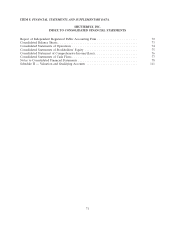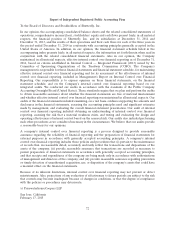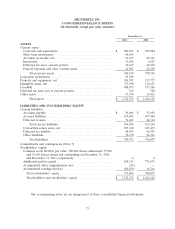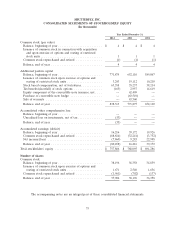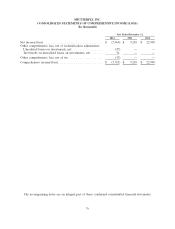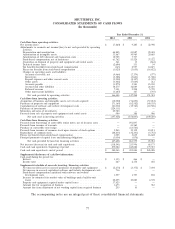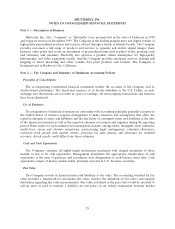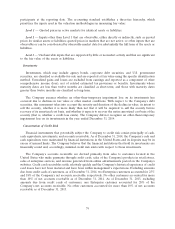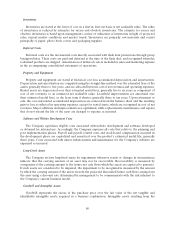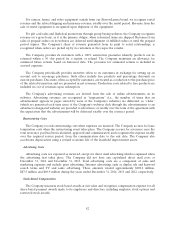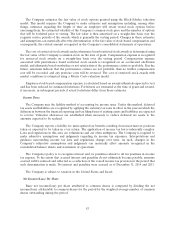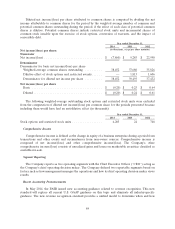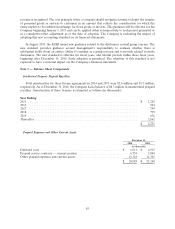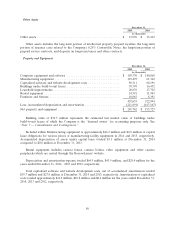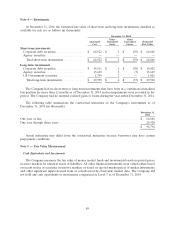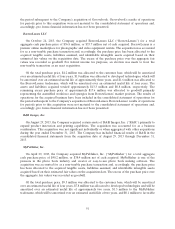Shutterfly 2014 Annual Report Download - page 82
Download and view the complete annual report
Please find page 82 of the 2014 Shutterfly annual report below. You can navigate through the pages in the report by either clicking on the pages listed below, or by using the keyword search tool below to find specific information within the annual report.acquisition of entities accounted for using the purchase method of accounting are estimated by
management based on the fair value of assets received. Intangible assets are amortized on a straight-line
basis over the estimated useful lives which range from one to sixteen years, and the amortization is
allocated between cost of net revenues and operating expenses. Goodwill and intangible assets with
indefinite lives are not subject to amortization, but are tested for impairment on an annual basis during the
fourth quarter or whenever events or changes in circumstances indicate the carrying amount of these assets
may not be recoverable.
For the Company’s annual goodwill impairment analysis, the Company operates under two reporting
units. The Company tests goodwill for impairment by first comparing the book value of net assets to the
fair value of the reporting units. If the fair value is determined to be less than the book value or qualitative
factors indicate that it is more likely than not that goodwill is impaired, a second step is performed to
compute the amount of impairment as the difference between the estimated fair value of goodwill and the
carrying value. The Company estimates the fair value of the reporting units using a combination of the
income approach (discounted cash flows) and the market approach. Forecasts of future cash flows are
based on our best estimate of future net sales and operating expenses, based primarily on expected
reporting unit expansion, pricing, market segment share, and general economic conditions.
Intellectual Property Prepaid Royalties
The Company has patent license agreements with various third parties. The Company has accounted
for these agreements as prepaid royalties that are amortized over the remaining life of the patents.
Amortization expense is recorded on a straight-line basis as a component of cost of revenue. The current
portion of the prepaid royalty is recorded as a component of prepaid expenses and the long term portion is
recorded in other assets.
Lease Obligations
The Company categorizes leases at their inception as either operating or capital leases. On certain of
our lease agreements, the Company may receive rent holidays and other incentives. The Company
recognizes lease costs on a straight-line basis without regard to deferred payment terms, such as rent
holidays that defer the commencement date of required payments. Additionally, incentives the Company
receives for leases categorized as operating leases are treated as a reduction of our costs over the term of
the agreement.
The Company establishes assets and liabilities for the estimated construction costs incurred under
build-to-suit lease arrangements to the extent the Company is involved in the construction of structural
improvements or takes construction risk prior to commencement of a lease. Upon occupancy of facilities
under build-to-suit leases, the Company assesses whether these arrangements qualify for sales recognition
under the sale-leaseback accounting guidance. If the Company continues to be the deemed owner, the
facilities are accounted for as financing leases.
Revenue Recognition
The Company recognizes revenue from Consumer and Enterprise product sales, net of applicable
sales tax, upon shipment of fulfilled orders, when persuasive evidence of an arrangement exists, the selling
price is fixed or determinable and collection of resulting receivables is reasonably assured. Customers place
Consumer product orders through the Company’s websites and pay primarily using credit cards. Enterprise
customers are invoiced upon fulfillment. Shipping charged to customers is recognized as revenue at the
time of shipment.
81


